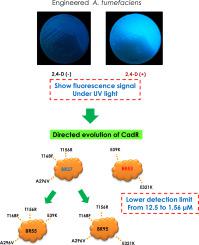Journal of Microbiological Methods ( IF 2.2 ) Pub Date : 2020-07-06 , DOI: 10.1016/j.mimet.2020.105997 Benjarat Ritcharoon 1 , Ratiboot Sallabhan 1 , Neal Toewiwat 2 , Skorn Mongkolsuk 3 , Suvit Loprasert 3

|
2,4-Dichlorophenoxyacetic acid (2,4-D)has been widely used as herbicide for agricultural purposes. Currently, the available methods for detecting 2,4-D require multi-step sample preparations and expensive instruments. Using a whole cell biosensor is an interesting approach that is straightforward and simple to use. In this study, we constructed a genetic-based Agrobacterium tumefaciens biosensor based on a cadA promoter and cadR regulator from Bradyrhizobiumsp. strain HW13 (2,4-D degrader) with the formylglycine generating enzyme (FGE)-sulfatase as the reporter genes. The performance of the biosensor was further improved through direct evolution of the cadR activator. The detection limit of cadR mutants for phenoxyacetic acid herbicides including 2,4-D and 4-Chlorophenoxyacetic acid (4-CPAA) were 1.56 μM (an eight-fold improvement compared to using wild-type CadR).The biosensor could detect 2,4-D in environmental samples without encountering interference from other complex compounds. TheAgrobacteriumbiosensor was also stable after storing in a simple Luria-Bertani (LB) medium at 4 °C for 30 days in which the activity remained at 82% when exposed to 100 μM of 2,4-D.This novel biosensor,with its high stability under simple storage conditions,exhibits promising potential for use as an inexpensive and easy-to-use tool to screen for 2,4-D contamination in environmental sources.
中文翻译:

使用基于FGE硫酸酯酶的全细胞农杆菌生物传感器检测2,4-二氯苯氧基乙酸除草剂。
2,4-二氯苯氧基乙酸(2,4-D)已被广泛用作农业除草剂。当前,用于检测2,4-D的可用方法需要多步骤的样品制备和昂贵的仪器。使用全细胞生物传感器是一种有趣的方法,它简单易用。在这项研究中,我们构建了基于遗传的根癌农杆菌生物传感器,该传感器基于Bradyrhizobium sp。的cadA启动子和cadR调节剂。菌株HW13(2,4-D降解剂),其中甲酰甘氨酸生成酶(FGE)-硫酸酯酶为报告基因。通过直接进化cadR激活剂,进一步提高了生物传感器的性能。cadR的检出限2,4-D和4-氯苯氧基乙酸(4-CPAA)的苯氧乙酸除草剂的突变体为1.56μM(与使用野生型CadR相比提高了八倍)。该生物传感器可以在环境中检测到2,4-D样品而不受其他复杂化合物的干扰。该农杆菌生物传感器在4°C的简单Luria-Bertani(LB)培养基中保存30天后仍保持稳定,当暴露于100μM2,4-D时其活性保持在82%。它在简单的储存条件下具有很高的稳定性,显示出用作筛选环境源中2,4-D污染物的廉价且易于使用的工具的潜力。


























 京公网安备 11010802027423号
京公网安备 11010802027423号